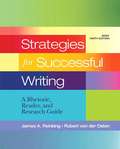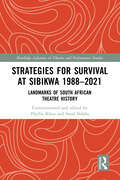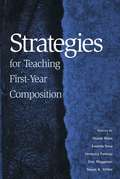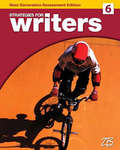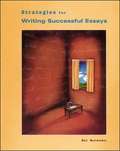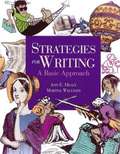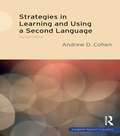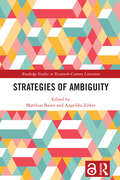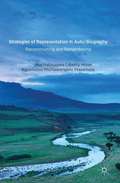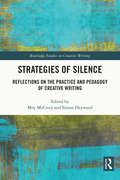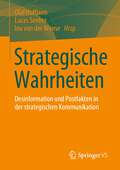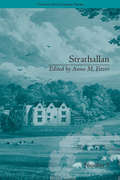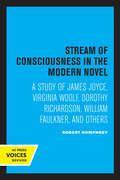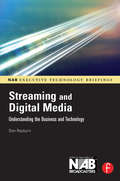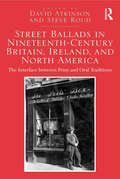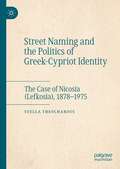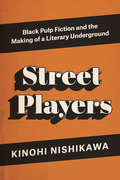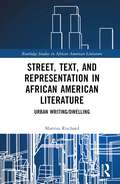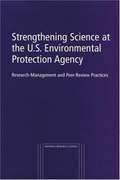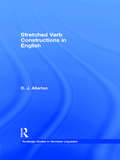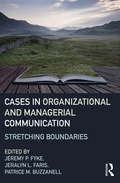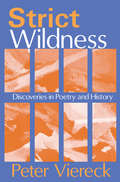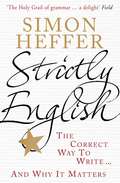- Table View
- List View
Strategies for Successful Writing: A Rhetoric, Research Guide, and Reader (Brief Edition, 9th Edition)
by James A. Reinking Robert von der OstenThe ninth edition of Strategies for Successful Writing: A Rhetoric, Research Guide, and Reader is a comprehensive textbook that offers ample material for a full-year composition course.
Strategies for Survival at SIBIKWA 1988 – 2021: Landmarks of South African Theatre History (Routledge Advances in Theatre & Performance Studies)
by Phyllis Klotz Smal NdabaThis book provides an engaging and contextualised insight into a South African township-based arts centre that has survived the vicissitudes of steady militarisation in townships during some of the worst years of apartheid as well as the exhilaration of a new democratic policy while attempting to circumnavigate different policies and funding dispensations. Sibikwa provides arts centres across the world and especially those in decolonising countries with strategies for survival in tumultuous times. This multi-disciplinary book maps and co-ordinates wider historical, political, and social contextual concerns and events with matters specific to a community-based east of Johannesburg and provides an exploration and analysis by experts of authentic theatre-making and performance, dance, indigenous music, arts in education and NGO governance. It has contemporary significance and raises important questions regarding inclusivity and transformation, the function and future of arts centres, community-based applied arts practices, creativity, and international partnerships. This study will be of great interest to students and scholars in theatre and performance, indigenous music, dance, and South African history.
Strategies for Teaching First-Year Composition
by Duane Roen Veronica Pantoja Lauren Yena Susan K. Miller Eric WaggonerThis book presents 93 essays that offer guidance, reassurance, and commentary on the many activities leading up to and surrounding classroom instruction in first-year composition. Essays in the book are written by instructors who teach in community colleges, liberal arts colleges, state university systems, and research institutions.
Strategies for Writers (6th grade) (Next Generation Assessment Edition)
by Rebecca Bowers Sipe L. Crawford"Features a rubrics-based instruction and a writing process with emphasis on prewriting and revising. Grammar is taught in conjunction with writing, so students learn how grammar is best applied to writing." (teacher's edition p.T2).
Strategies for Writing Successful Essays
by Nell MeriwetherA quick and easy to use guide to writing an essay.
Strategies for Writing: A Basic Approach
by Ann E. Healy Martha WalusayiA composition textbook illustrated and written with a lot of model essays, an introduction to writing resumes and cover letters, numerous individual and small-group exercises throughout the text to make the reader become a more flexible writer.
Strategies in Learning and Using a Second Language (Applied Linguistics And Language Study Ser.)
by Andrew D. CohenStrategies in Learning and Using a Second Language examines what it takes to achieve long-term success in languages beyond the first language. Distinguishing language learning from language-use strategies, Andrew D. Cohen disentangles a morass of terminology to help the reader see what language strategies are and how they can enhance performance. Particular areas of research examined in the book include: - links between the use of task-specific strategies and language performance - how multilinguals verbalise their thoughts during language learning and use strategies that learners use in test-taking contexts In this fully revised and substantially rewritten second edition, every chapter has been reworked, with material either updated or replaced. Entirely new material has also been developed based on examples of specific strategies supplied by actual learners, mostly drawn from a website featuring these strategies in the learning of Spanish grammar.Strategies in Learning and Using a Second language will be an invaluable resource for language teachers and researchers, as well as for administrators of second language programmes and for students of applied linguistics.
Strategies of Ambiguity (Routledge Studies in Twentieth-Century Literature)
by Matthias Bauer Angelika ZirkerThere has been a growing awareness that ambiguity is not just a necessary evil of the language system resulting, for instance, from its need for economy, or, by contrast, a blessing that allows writers to involve readers in endless games of assigning meaning to a literary text. The present volume contributes to overcoming this alternative by focusing on strategies of ambiguity (and the strategic avoidance of ambiguity) both at the production and the reception end of communication. The authors examine ways in which speakers and hearers may use ambiguous words, structures, references, and situations to pursue communicative ends. For example, the question is asked what it actually means when a listener strategically perceives ambiguity, which may happen both synchronically (e.g. in conversations) as well as diachronically (e.g. when strategically ambiguating biblical texts in order to make them applicable to moral lessons). Another example is the question whether ambiguity awareness increases the strategic use of ambiguity in prosody. Moreover, the authors not only enquire into effects of ambiguous meanings but also into the strategic use of ambiguity as such, for example, as a response to censorship or as a means of provoking irritation. This volume brings together several contributions from linguistics, literary studies, rhetoric, psychology and theology, and aims at providing a systematic approach to the strategic production and perception of ambiguity in a variety of texts and contexts. The Open Access version of this book, available at http://www.taylorfrancis.com, has been made available under a Creative Commons Attribution-Non Commercial-No Derivatives 4.0 license.
Strategies of Ambiguity (Routledge Studies in Twentieth-Century Literature)
by Matthias Bauer Angelika ZirkerThere has been a growing awareness that ambiguity is not just a necessary evil of the language system resulting, for instance, from its need for economy or, by contrast, a blessing that allows writers to involve readers in endless games of assigning meaning to a literary text. The present volume contributes to overcoming this alternative by focusing on strategies of ambiguity (and the strategic avoidance of ambiguity) both at the production and the reception end of communication. The authors examine ways in which speakers and hearers may use ambiguous words, structures, references, and situations to pursue communicative ends. For example, the question is asked what it actually means when a listener strategically perceives ambiguity, which may happen both synchronically (e.g. in conversations) as well as diachronically (e.g. when strategically ambiguating biblical texts in order to make them applicable to moral lessons). Another example is the question of whether ambiguity awareness increases the strategic use of ambiguity in prosody. Moreover, the authors enquire not only into the effects of ambiguous meanings but also into the strategic use of ambiguity as such, for example, as a response to censorship or as a means of provoking irritation. This volume brings together several contributions from linguistics, literary studies, rhetoric, psychology, and theology, and it aims to provide a systematic approach to the strategic production and perception of ambiguity in a variety of texts and contexts.The Open Access version of this book, available at http://www.taylorfrancis.com, has been made available under a Creative Commons Attribution-Non Commercial-No Derivatives 4.0 license.
Strategies of Representation in Auto/biography
by Muchativugwa Hove Kgomotso MasemolaStrategies of Representation in Auto/biography investigates how selves are represented and reconstructed in selected auto/biographical readings from African literary discourse. It examines how such representations confirm, validate, interrogate and pervade conversations with issues of identity, nation and history. In addition to providing an overview of the multidimensionality of auto/biography, the book also introduces readers to various ways of reading and analysing auto/biographical writings and develops specific perspectives on the genre and views inherently expressed through the re-imagined, re-membered and re-constructed self that speaks through the pages of autobiographical scripting. The focus on auto/biographical writings from southern Africa, specifically South Africa and Zimbabwe, offers a fresh reading of the work of significant figures in the political, economic and sociological spheres of these nation states. This collection shows that auto/biography may be more than simply the representation of an individual life, and that the socio-cultural memory of a people is a core aspect influencing individual self-representation.
Strategies of Silence: Reflections on the Practice and Pedagogy of Creative Writing (Routledge Studies in Creative Writing)
by Simon Heywood Moy McCroryThis unique book takes silence as its central concept and questions the range of meanings and values which inform the idea as it impinges on the creative process and its content and contexts. The thematic core of silence allows a consideration of silencing and silence as opposite ends of a spectrum: one shutting down, the other enabling and opening up. As a multidisciplinary collection of essays derived from the teaching and implementation of Creative Writing at university level, the contributors consider silence as strategic, both through the need for silence and as something which compels resistance. They explore how writing has employed images and tropes of silence in the past, and used silence and gaps technically. In considering marginalised and forgotten voices, this book shows how writers bring their diverse range of backgrounds and experience to work with and against silence in Creative Writing Studies. The first theoretical work on silence in Creative Writing, this field-shifting book is an essential read for both practitioners and students of Creative Writing at the higher education level.
Strategies to Achieve Reading Success (Star Series #F)
by Curriculum AssociatesStrategies to Achieve Reading Success Star Series F
Strategische Wahrheiten: Desinformation und Postfakten in der strategischen Kommunikation
by Olaf Hoffjann Lucas Seeber Ina von der WenseStrategische Kommunikation zielt mit ihren kontingenten Wirklichkeitsbeschreibungen seit jeher auf gesellschaftliche Wahrheitsmodelle. Wie häufig gesellschaftliche Wahrheitsmodelle auf strategische Kommunikationsbemühungen zurückgehen, auf Unwahrhaftigkeit beruhen und damit zumindest zeitweise zu strategischen Wahrheiten werden, zeigen eindrucksvoll zwischenzeitlich geglaubte Wahrheiten, die sich als Lüge entpuppt haben: von Walter Ulbrichts „Niemand hat die Absicht, eine Mauer zu errichten“ über Hitlers Tagebücher bis hin zu den Massenvernichtungswaffen im Irak. Die erfolgreichen Kampagnen der Brexiteers und von Donald Trump 2016 haben diesem Thema zu neuer und bislang ungeahnter Aufmerksamkeit verholfen. Während die Themen Desinformation und postfaktische Gesellschaft die Journalismus-, politische Kommunikations- und Medienethikforschung aktuell zu dominieren scheinen, ist das Schweigen der deutschsprachigen und internationalen PR- und Organisationskommunikationsforschung auffällig. Dies ist umso bemerkenswerter, weil die PR-Wissenschaft in der Vergangenheit immer wieder versucht hat, ihren Gegenstand zu schärfen, indem sie sich am Begriff der Propaganda abgearbeitet hat. Daraus müsste eigentlich eine Affinität für das Thema Desinformation resultieren. Aber genau das Gegenteil ist offensichtlich der Fall: Hat sich die PR-Wissenschaft gerade deshalb nicht mit Desinformation beschäftigt, weil sie sich so dezidiert von Propaganda und darin eingeschlossenen desinformierenden und manipulativen Techniken abgrenzen will? Was sind die Gründe hierfür? Glauben wir, bereits alles zum Thema gesagt zu haben? Liegt dies daran, dass sich die PR- und Organisationskommunikationsforschung seit jeher vor allem für Unternehmen und weniger für politische und Non-Profit-Organisationen interessiert? Oder fühlen wir uns hier schlicht und ergreifend nicht zuständig? Es scheint offenkundig höchste Zeit zu sein, sich wieder eingehend mit Fragen der Desinformation aus der Perspektive der strategischen Kommunikationsforschung zu befassen. Die Beiträge des Tagungsbandes fokussieren hierzu auf neue theoretische Perspektiven, normative Bewertungen und empirische Befunde.
Strathallan: by Alicia LeFanu (Chawton House Library: Women's Novels)
by Anna M FitzerA novel, which addresses central themes of adultery, obsession and inheritance. It follows the fortunes of Matilda Melbourne who displays virtue, delicacy and an unwavering commitment to the sometimes ruthless demands of parental authority.
Stream of Consciousness in the Modern Novel: A Study of James Joyce, Virginia Woolf, Dorothy Richardson, William Faulkner, and Others
by Robert HumphreyThis title is part of UC Press's Voices Revived program, which commemorates University of California Press’s mission to seek out and cultivate the brightest minds and give them voice, reach, and impact. Drawing on a backlist dating to 1893, Voices Revived makes high-quality, peer-reviewed scholarship accessible once again using print-on-demand technology. This title was originally published in 1954.
Streaming and Digital Media: Understanding the Business and Technology (Nab Executive Technology Briefings Ser.)
by Dan RayburnSteaming and Digital Media gives you a concise and direct analysis to understand a scalable, profitable venture, as well as the common and hidden pitfalls to avoid in your business. By focusing on both the business implications and technical differences between online video and traditional broadcast distribution, you will learn how to gain significant time-to-market and cost-saving advantages by effectively using streaming and digital media technologies. As part of the NAB Executive Technology Briefing series, the book is geared towards the manager or executive and no technical prerequisite is required. You can quickly learn the technical speak as well as the market and business implications.New In The Book: - Consumer generated content and portals- Distribution of full-length video content- New distribution outlets for delivering content (Sling, TiVO, IPTV)- Addition of Flash streaming technology and Podcasting- Up-to-date market research and data- New industry pricing data
Street Ballads in Nineteenth-Century Britain, Ireland, and North America: The Interface between Print and Oral Traditions
by Steve Roud David AtkinsonIn recent years, the assumption that traditional songs originated from a primarily oral tradition has been challenged by research into ’street literature’ - that is, the cheap printed broadsides and chapbooks that poured from the presses of jobbing printers from the late sixteenth century until the beginning of the twentieth. Not only are some traditional singers known to have learned songs from printed sources, but most of the songs were composed by professional writers and reached the populace in printed form. Street Ballads in Nineteenth-Century Britain, Ireland, and North America engages with the long-running debate over the origin of traditional songs by examining street literature’s interaction with, and influence on, oral traditions.
Street Naming and the Politics of Greek-Cypriot Identity: The Case of Nicosia (Lefkosia), 1878–1975
by Stella TheocharousThis book is the first to explore street names and street-naming in the formation of a Greek-Cypriot identity in the cityscape of Nicosia between 1878 and 1975. Rather than treating toponymy as a direct linguistic act of spatial orientation, the book approaches street-naming as a contested practice involving those shared symbols and representations used to depict official history and collective identity as part of a political process. It considers how street names are part of the symbolic politics of space, and how authorities transformed the streets of Nicosia into arenas of struggle for the control of symbolic and material space. It documents historical efforts over the course of a century to impose a ‘geography of forgetting’ to buttress national identity and to cast out the ‘other’ from space — both literally and symbolically — so as to achieve territorial dominance and political legitimacy. The book is another step towards the development of a global perspective on the critical study of street-naming, thereby refining and expanding our knowledge of the political dynamics involved in the process. In their commemorative capacity, street names belong to the politics of public memory and identity.
Street Players: Black Pulp Fiction and the Making of a Literary Underground
by Kinohi NishikawaThe uncontested center of the black pulp fiction universe for more than four decades was the Los Angeles publisher Holloway House. From the late 1960s until it closed in 2008, Holloway House specialized in cheap paperbacks with page-turning narratives featuring black protagonists in crime stories, conspiracy thrillers, prison novels, and Westerns. From Iceberg Slim’s Pimp to Donald Goines’s Never Die Alone, the thread that tied all of these books together—and made them distinct from the majority of American pulp—was an unfailing veneration of black masculinity. Zeroing in on Holloway House, Street Players explores how this world of black pulp fiction was produced, received, and recreated over time and across different communities of readers. Kinohi Nishikawa contends that black pulp fiction was built on white readers’ fears of the feminization of society—and the appeal of black masculinity as a way to counter it. In essence, it was the original form of blaxploitation: a strategy of mass-marketing race to suit the reactionary fantasies of a white audience. But while chauvinism and misogyny remained troubling yet constitutive aspects of this literature, from 1973 onward, Holloway House moved away from publishing sleaze for a white audience to publishing solely for black readers. The standard account of this literary phenomenon is based almost entirely on where this literature ended up: in the hands of black, male, working-class readers. When it closed, Holloway House was synonymous with genre fiction written by black authors for black readers—a field of cultural production that Nishikawa terms the black literary underground. But as Street Players demonstrates, this cultural authenticity had to be created, promoted, and in some cases made up, and there is a story of exploitation at the heart of black pulp fiction’s origins that cannot be ignored.
Street, Text, and Representation in African American Literature: Urban Writing/Dwelling (Routledge Studies in African American Literature)
by Mattius RischardComprehensive and comparative, this volume investigates African American street novelists since the Chicago Black Renaissance and the semiotic strategies they employ in publication, consumption, and depiction of street life. Divided into three chapters, this text analyzes the content, style, and ethics of “street” narrative through a discursive/rhetorical lens, exploring the development of street literature’s formal and contextual concerns to resolve the sociocultural and political questions surrounding cultural work. The book also gives emphasis to “text” or (post)structural literary analysis by answering questions about the genre’s aesthetic and linguistic techniques that respond to the injustices of urban planning. The last chapter, “Representation,” investigates the phenomenological hermeneutics of more recent street literature and its satire, highlighting the political stakes for authorship, credibility, and subjectivity. Through historical and contemporary studies of urban space, Blackness, and adaptations of street literature, this work attempts to network activists, artists, and scholars with the greater reading public by providing a functional ontology of reading the inner city.
Strengthening Science at the U.S. Environmental Protection Agency: Research-Management and Peer-Review Practices
by Committee on Research Peer Review in EPAInformation on Strengthening Science at the U.S. Environmental Protection Agency
Stretched Verb Constructions in English (Routledge Studies in Germanic Linguistics)
by D. J. AllertonConstructions such as 'make an accusation against', or 'give one's approval for' can be seen as 'stretched' versions of simple verbs, such as 'accuse' or 'approve of'. What is the precise linguistic nature of stretched verbs, and how many basic types are there? What kinds of grammatical connections are involved, and what lexical limits are there on these constructions? What is their precise semantic value? These are some of the questions that this book sets out to answer in its investigation of stretched verb constructions.
Stretching Boundaries: Stretching Boundaries
by Patrice M. Buzzanell Jeremy Fyke Jeralyn FarisStretching Boundaries: Cases in Organizational and Managerial Communication focuses on non-traditional organizations in a variety of contexts. Because cases range from small family-owned entrepreneurships and cybervetting to provincial egovernment democratic movements in China, this supplemental text enables a reexamination of the boundaries of traditional organizational contexts. Cases delve into organizing structures, relationships, and visions for global not-for-profits, hybrid, creative industry, and entrepreneurial organizations. This book stands to benefit instructors and students in at least four ways. First, it provides instructors with an application-based teaching tool to help spark discussion. Second, students will find the case studies interesting and applicable to their future work lives, especially undergraduates who will soon be in the work force. Additionally, cases help students grasp course materials that may be otherwise challenging. Finally, for graduate students, the book encourages reflection on important topics for future research.
Strict Wildness: Discoveries in Poetry and History
by Peter ViereckA reviewer once called Peter Viereck's thought "not common sense but inspired, electric common sense." This volume of Viereck's selected essays on poetry and on history, written between 1938 through 2004, exemplifies this quality. Its main theme is suggested in Viereck's coined phrase "strict wildness," which suggests a balance between restraint (which by itself is staid and rigid) and passion (which by itself is incoherent). Frost called free verse tennis without the net. Viereck calls dead mechanical form "net without the tennis." Strict wildness, then, is spontaneity of feeling within strict organic form.The book explores questions of modernism and poetic craft with respect to American poetry. It discusses the controversy over Ezra Pound's politics and its relation to his poetics, as well as the nearly forgotten poet Vachel Lindsay. Viereck offers more general views on poetics, including the fruitful tensions between form and content, and the impact of modern technology on poetic expression. He also discusses history and politics, and contains essays on McCarthyism, the Cold War, political conformity of the Left and Right, and discusses issues of historiography and culture that define Viereck's highly individual, often critical brand of conservatism. In treating representative trends and figures in conservative thought, Viereck insists on clear awareness of what exists to conserve, what ought to be conserved, and why it should be conserved.In their range and originality, the writings brought together in Strict Wildness constitute an ideal introduction to Peter Viereck's literary and political thought and how they come together. It will be of interest to literary scholars, intellectual historians, and social scientists. The introduction allows the reader to grasp a clear sense of the context and background of Viereck's works.
Strictly English: The correct way to write ... and why it matters
by Simon Heffer"Be in no doubt: the beer was drunk but the man drank the beer.""We must avoid vulgarities like 'front up'. If someone is 'fronting up' a television show, then he is presenting it."Simon Heffer's incisive and amusingly despairing emails to colleagues at the The Daily Telegraph about grammatical mistakes and stylistic slips have attracted a growing band of ardent fans over recent years. Now, in his new book Strictly English, he makes an impassioned case for an end to the sloppiness that has become such a hallmark of everyday speech and writing, and shows how accuracy and clarity are within the grasp of anyone who is prepared to take the time to master a few simple rules.If you wince when you see "different than" in print, or are offended by people who think that "infer" and "imply" mean the same thing, then this book will provide reassurance that you are not alone. And if you believe that precise and elegant English really does matter, then it will prove required reading.
